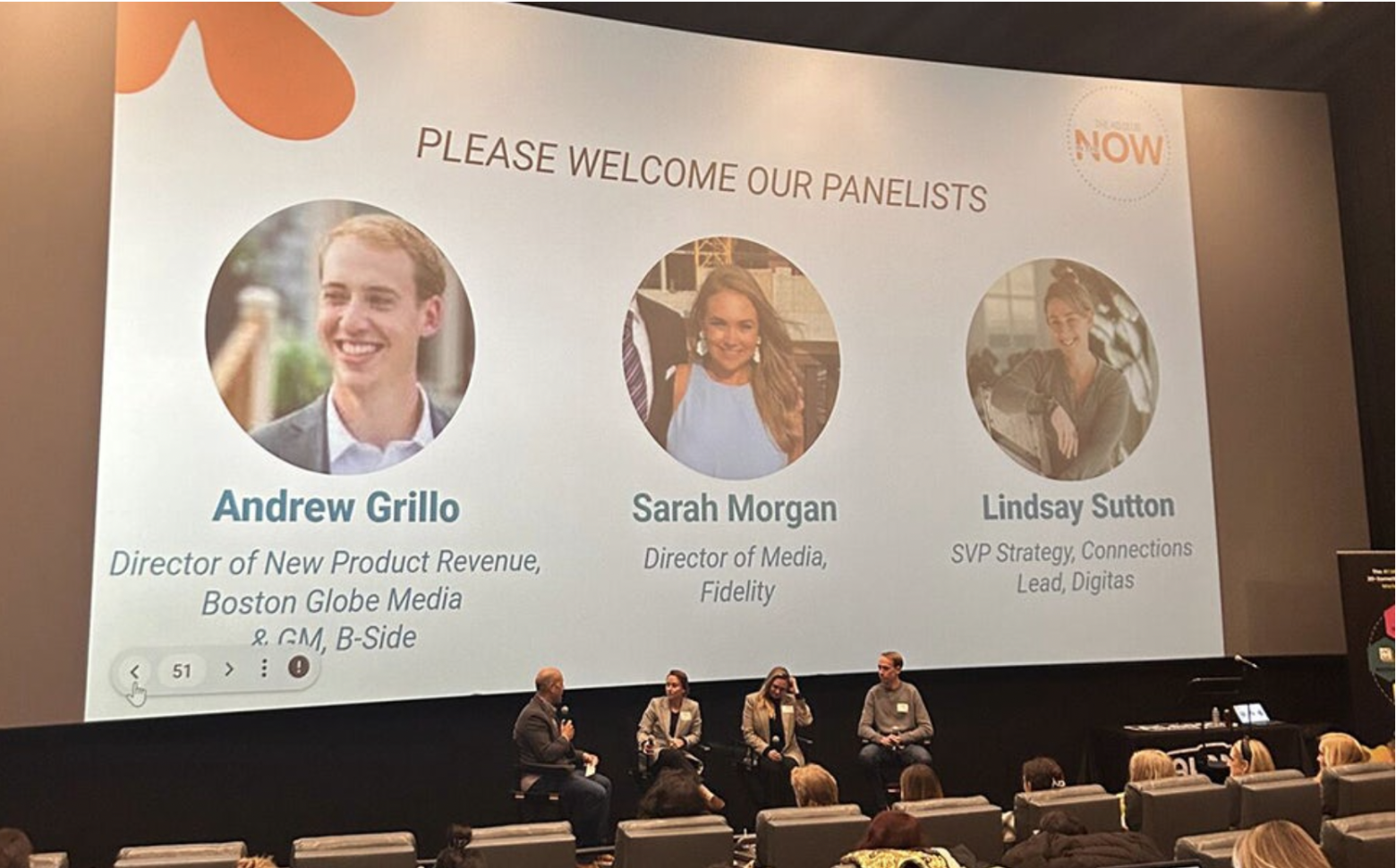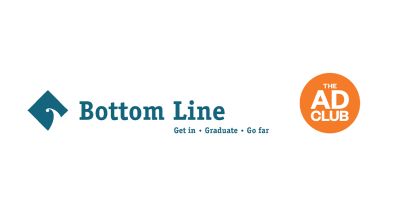Industry experts discuss how brands can build genuine connections with Gen Z and navigate the evolving consumer landscape.
BY TORI WALTZ
Adaptive. Discerning. Tech savvy. These are the defining traits that set Generation Z apart as a powerful — yet elusive — demographic of consumers.
From their ability to sniff out insincere marketing efforts to their rapid adoption of online trends, Gen Z has proven itself a difficult market for brands to organically tap into. However, companies like Her Campus Media, the Boston Globe’s B-Side, Fidelity, and Digitas seem to have cracked the code. At The Ad Club’s “In the Now: Marketing to Gen Z” event on Feb. 29, industry leaders and experts shared their insights on how brands can effectively engage with Gen Z through innovative digital strategies, authentic storytelling, and meaningful brand experiences.
What makes Gen Z different?
Born from 1996 to 2010 and coming of age in the digital era, Gen Z represents 40 percent of global consumers and commands an impressive $450 billion in purchasing power. However, behind their economic influence lies a challenge: Gen Z is anything but predictable.
While previous generations might have been easily swayed by traditional advertising and marketing tactics, Gen Zers are quick to spot anything less than genuine. They want transparency, inclusivity, and authenticity from the brands they engage with, making it essential for marketers to adapt their strategies accordingly.
“You need to be everywhere, all at once, consistently and authentically engaging with Gen Z in order to cut through the noise.” — Windsor Western
Windsor Western, co-founder and president, and Katrina Campanale, senior vice president of sales & partnerships at Her Campus Media, a Boston-based media portfolio for Gen Z and college students, are experts at meeting this demand. With an entire channel at their company dedicated to “GenZology” — the science behind Gen Z — they help Fortune 500 and Boston-based brands power their Gen Z marketing strategies through an emphasis on digital and social campaigns, influencers, ambassador programs, events, and more.
“You need to be everywhere, all at once, consistently and authentically engaging with Gen Z in order to cut through the noise,” says Western.
There are three key strategies Western and Campanale recommend brands adopt when seeking to craft marketing campaigns that successfully target Gen Z consumers.
1. Using the right channels
It’s no secret that Gen Z is chronically online, with over half of the demographic viewing social media as an important part of their personal brand. A study by Her Campus Media with responses from over 2,000 college students found that Gen Z women gravitate toward Instagram, TikTok, and Snapchat for media consumption, while men tend to lean more toward YouTube, Instagram, and Discord. It’s critical for marketers to understand these preferences when selecting platforms to communicate from and tailor their content accordingly.
However, simply choosing the right platform isn’t enough to guarantee success. For brands like Boston Globe Media’s B-Side newsletter, connecting with this demographic also means understanding their language, motivations, and interests.
“The majority of Gen Z are in their inbox everyday, whether they’re a student or young professional. But how we use the real estate of that newsletter is unique,” says Andrew Grillo, director of new product revenue at Boston Globe Media and general manager of B-Side. He explains how his team constructed B-Side with Gen Z readers’ passions and interests in mind, offering a careful blend of entertaining and informative content to create a trusted source of news, culture, and trends among young readers in the Boston area.
2. Peer-driven approach
When it comes to targeting Gen Z, embracing a peer-driven approach to marketing isn’t just an option; it’s essential. “Gen Z is looking for a relatable, informed friend,” says Grillo, with the demographic placing more trust in influencers and peer recommendations than traditional advertising strategies.
“Gen Z is looking for a relatable, informed friend.” — Andrew Grillo
B-Side has mastered this style of marketing through peppering its newsletter with engaging native ads that seamlessly blend in with the rest of the content. Harnessing his team of young writers, and leveraging expertise from other Boston Globe Media newsrooms, Grillo created a unique voice that speaks to readers as a peer rather than a distant authority figure, allowing for a more genuine and relatable connection to be formed.
“You want the reader to feel like they’re having a milkshake but then sprinkle in those essential vitamins,” says Grillo, describing how the newsletter still provides readers with timely, relevant news in a fun and digestible way.
Another prime example of how brands can integrate a peer-driven marketing approach is Her Campus Media’s Creators Loft, a pop-up event space in the heart of Manhattan for thousands of Gen Z micro-influencers and rising creators to gather for programming, networking, collaborating, and engaging brand activations during New York Fashion Week. Their February 2024 partners included Kate Spade New York and imPRESS Falsies by KISS. Attendees were able to check out the Kate Spade handbags to borrow for the day and encouraged to share their experiences on social media. This led to a flood of organic user-generated content that featured Gen Zers enjoying the event with their Kate Spade bags in hand, effectively marketing the fashion designer’s products in a new and creative way. Additionally, the imPRESS by KISS Lash Bar was an educational activation which gave attendees the chance to freshen up their glam and post on social media.
Gen Z’s trust in their peers can also be important for marketers in other sectors of business, like finance and insurance. Fidelity Investments, for instance, places a high priority on influencer-driven campaigns that inform and educate their Gen Z audience without putting too much pressure on them to act.
“Authenticity is paramount for this audience. So with our influencers, we make sure that we’re not spoon feeding them and allowing them to lean into their own financial journeys to tell the story that they need to tell,” says Sarah Morgan, director of media at Fidelity. “Finances can be really scary, and when you have someone like an influencer that they can think of as a friend, it really helps to drive the message.”
3. Staying up-to-date on trends
Nothing discredits a brand in the eyes of Gen Z more than being out of touch, which is why it’s crucial for marketers to consistently monitor trends and adapt their strategies to stay relevant.
“The media and advertising landscape is rapidly changing, especially when it comes to reaching the next generation and point of entry consumers,” says Campanale. “What worked three months ago might not work next month.”
Data shows that Gen Z women today are heavily drawn to content formats like Get Ready With Me (GRWM) and haul videos, routine videos, vlogs, product reviews, content from friends, and tutorials/DIYs. They prefer short, authentic, and visually engaging content, often consuming it via Stories rather than in-feed posts. Platforms like TikTok have also emerged as primary sources of content discovery for Gen Z, with over half of the demographic using it as their go-to search engine over Google. That said, many Gen Z users remain wary of social media shopping platforms like TikTok Shop, turning to more trusted ecommerce sources instead.
“It’s very important that no matter what, you’re going into the day looking at what content is being published and saying ‘Is this fit for the audience, fit for the opportunity, and fit for what’s happening in today’s news cycle?’” — Lindsay Sutton
Lindsay Sutton, who serves as the senior vice president of strategy and connections lead at Digitas, uses her understanding of these trends to attract Gen Z consumers for iconic brands like Dunkin’ and many others.
“It’s very important that no matter what, you’re going into the day looking at what content is being published and saying ‘Is this fit for the audience, fit for the opportunity, and fit for what’s happening in today’s news cycle?’” says Sutton.
Among these strategies for effective marketing, one thing remains clear: Gen Z poses both a challenge and opportunity for brands willing to adapt and innovate. By meeting consumers where they are — adopting an authentic, adaptive, and digitally focused mindset — marketers can not only capture the attention of Gen Z, but also retain it in an ever-changing market environment.
To learn more about the strategies discussed at the event and how to effectively engage with Gen Z consumers, check out the sponsors — Undertone, the Boston Globe’s B-Side, Fidelity Investments, Digitas, and Her Campus Media — who made the event possible. If you’re interested in becoming a member of The Ad Club and attending future events, visit The Ad Club website for more details.
This content was produced by Boston Globe Media's Studio/B in collaboration with the advertiser. The news and editorial departments of The Boston Globe had no role in its production or display.




